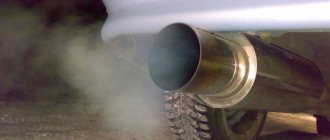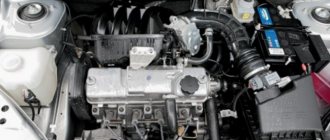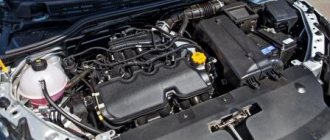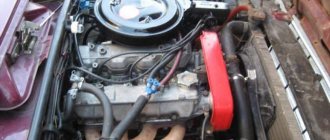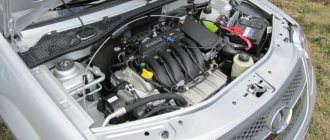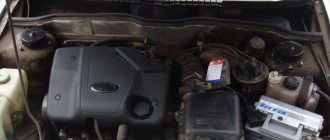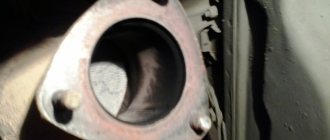general information
On Lada Xray models, engines are available in three variations, but their general design is similar: gasoline inline four-cylinder units, with 4 valves per cylinder (16 valves in total) and two camshafts.
True, this is where the similarities between the engines end. Considering the general characteristics of the Lada Xray, the engines installed on the model provide good power and torque, which is quite enough for everyday city use. Let's take a closer look at which engines are equipped with x-rays and what are their main differences. However, before this it is worth mentioning that not all car models and trim levels are equipped with domestic power units. It will not be a secret for advanced car enthusiasts that new Lada models are created on the basis of the B0 platform. And since AvtoVAZ assembles models using Renault-Nissan technologies, many engineering solutions are borrowed from these manufacturers. The motor in this case was no exception, so AvtoVAZ installs the Nissan engine on the Xray in some trim levels.
The news about the appearance of the X-ray with a Nissan engine inspired many fans of the brand, since VAZ engines have never been distinguished by excellent quality and reliability. And now there is an alternative, a massive and reliable one. The Nissan engines with which AvtoVAZ equips new models have long been known among car enthusiasts, since the origins of the creation of this unit date back almost to the beginning of the 2000s.
The model of this power unit is H4M, which is essentially a converted version of the Nissan HR16DE engine. This unit appeared on the market in the early 2010s and during this time has proven itself well among servicemen and owners of Renault Sandero, Logan, Duster, etc. Since 2015, full-scale production of the Lada X Ray with Nissan engines began, although the name of the engine itself was changed to N4Mk.
The displacement of the N4Mk engine is the classic 1.6 liters, and the power of the Lada X Ray with a Nissan engine is 110 hp, and the torque varies at around 146-148 Nm. Structurally, the H4Mk is an aluminum cylinder block and an aluminum cylinder head. The valves in the cylinder head are located on classic mechanical pushers, and the timing mechanism is carried out through the use of a chain in the design. There are two camshafts in the head, and there is a phase regulator on the intake shaft. The fuel injection system is electronic, with two injectors per cylinder.
The xray with the H4Mk engine has proven itself well over the years. The engine is reliable and maintains its service life of 200+ thousand without any problems, taking into account regular maintenance and careful operation. Of course, we can’t do without sores:
Is there a difference in maintenance costs?
This question is much more important than it initially seems. Indeed, given approximately the same power, torque and minor differences in dynamic characteristics, many expect that the service price tags will be approximately the same. But it was not there! There is a difference and it is very significant!
In order to understand this, it is enough to simply calculate the total costs of undergoing scheduled maintenance of a LADA XRAY with a 110-horsepower H4M engine. As an example, it is reasonable to take a mileage of 90,000 km and prices at Moscow LADA dealership centers. In addition, it is immediately necessary to clarify that the service interval for the Nissan H4M engine and the domestic 106-horsepower unit is the same - 15,000 km. They can also be filled with the same oil from Rosneft.
There are no differences in the list of operations and components during the first 5 maintenance procedures – up to a mileage of 75,000 km. It is necessary to change the engine oil and filters (air, cabin and oil). The only difference is the price, since the components for a foreign motor are slightly more expensive than for a domestic one. In particular, the amounts for TO-1, TO-3 and TO-5 differ - for an X-Ray with a Russian engine, service will cost 5,900 rubles per visit, and for a hatchback with an H4M under the hood - 6,500 rubles.
The difference in the price for maintenance for X-rays with different engines is quite noticeable.
Everything is complicated by the situation with the spark plugs. Their replacement interval is indicated at 30,000 km, but not everything is so simple. For a VAZ engine, their cost is already included in the price of TO-2 and TO-4, which cost 6,900 rubles each. But owners of X-Rays with H4M units have to pay separately for both spark plugs and replacements. As a result, TO-2 and TO-4 cost 8,800 rubles each, and another 4,000 rubles for each of these TO will be spent on replacing spark plugs.
This cost is due to 2 factors:
- For the H4M, spark plugs from the NGK company are used, while for the Russian engine, spark plugs from Bosch, made in Russia (Saratov), are intended;
- Difficult to replace - to do this you have to dismantle the intake manifold and throttle.
The H4M engine requires expensive spark plugs, and changing them is not easy.
However, the greatest expenses await the owner of an imported engine after traveling the first 90,000 km, when the time comes for TO-6. For the owner of an X Ray with a Russian engine, this maintenance will cost 12,000 rubles, but the owner of a hatchback with an H4M engine will have to pay the dealer as much as 34,500 rubles (including spark plugs)!
The almost 3-fold difference in price is explained by the cost of the alternator belt and rollers. For a Nissan engine they are much more expensive than for a Russian one.
The result is not the most rosy, because for the first 90,000 km the owner of a Lada X-Ray with a domestic, 106-horsepower engine will need to pay a total of 42,500 rubles. But the costs of the owner of a LADA XRAY with an H4M engine will reach 79,600 rubles. The final difference is 37,100 rubles.
LADA XRAY with H4M engine can only be purchased in the Yubileiny configuration.
Which engine is better for the Lada x Ray Cross?
Engine 21129 is used for the basic configuration of the new Lada and has significantly lower performance compared to the VAZ-21179. In particular, the fuel economy indicator.
Experts advise taking a closer look at the more expensive xRay options. After all, by paying an additional 39,000 rubles, you can save significantly in the long term. If the car is actively used, then these costs will pay off even faster. In addition, it is much more pleasant to drive a more dynamic car model.
Fans of mechanics should pay attention to the 122-horsepower engine, here the surcharge will be 64,000 rubles from the budget version. But this cost includes not only a more powerful engine and automatic transmission, but also more rich functionality of multimedia systems. It is also expected that this particular power unit will be installed on the budget version of the all-wheel drive Lada XRay Cross.
An important factor in choosing an engine for a car is the cost of its maintenance. Auto News calculated that servicing a Lada xRay Cross with a Nissan H4M engine after passing all maintenance will cost 38,000 thousand rubles more. It is to reduce the maintenance of X Rey that AvtoVAZ limits their production with an imported engine.
Xray with VAZ engines
AvtoVAZ decided to please potential X Ray buyers and released several new engine models:
Let's look at these Lada X-ray engines and figure out which one is better, more reliable and more economical. So, the origins of power units 21129 and 21179 begin with the release of VAZ models of the 10th family. The general design of the engines has not changed much since then: displacement from 1.4 to 1.6 (and for 1.8 on unit 179) with 4 valves per cylinder and two camshafts, timing mechanism - belt, fuel type - gasoline.
With each new VAZ model, engineers refine these engines, trying to find the optimal balance of power and reliability. Since there are no fundamental changes in their design, in terms of maintainability, everything is excellent with these motors. Now on the market there is simply a myriad of parts for these power units.
About Lada X Ray engines
Lada X Ray is a small crossover from AvtoVAZ, created on the B0 platform (Renault Duster, Sandero, etc.) and produced since 2021. This car, despite the appearance of a small jeep, has a front-wheel drive suspension. The goal of the Lada X Ray is to conquer part of the market in the fairly well-known and growing section of small crossovers.
Rivals of Lada Lada X Ray: Renault Duster/Sandero, Nissan Terrano, Hyundai Creta, Cherry Tiggo, Great Wall M4, Geely MR Cross and other similar SUVs.
Like all the latest models from Togliatti, X-Ray received the newest engine. In fact, the car is equipped with 2 engines - the first is from Lada Vesta, a 1.6-liter unit 21129. The second is a Nissan HR16 (H4M) engine, which is a more expensive option, but the displacement is the same as on the Russian engine of 1.6 liters. The more high-torque Lada X Rays are equipped with 1.8 liter 21179 engines, the power of which reaches 122 hp.
CAR.RU will tell you about X Ray engines, what makes them stand out, tell you about the main difficulties in maintenance and the reasons for various problems. And of course, about the technical properties, service life, required oil and replacement frequency. Let's touch on the topic of engine tuning, how to increase power without reducing the engine's service life.
Engine 21179:
The engine uses the entire cylinder block from Priora 21126, 197.1 mm high, with a slightly improved cooling system and an oil channel for the phase shifter. Pistons supplied are 82 mm and 26.7 mm high, a crankshaft with a piston stroke of 84 mm, connecting rods of 128 mm. The weight of the connecting rods and pistons is approximately the same as the 126th engine. Assembling the engine with these parts made it possible to obtain a working volume of 1.8 liters. A modified cylinder head 21126 was placed on top, with a new gasket installed. For the first time, a variable valve timing system was used on the intake camshaft. The adjustment range is 30 degrees, the camshafts themselves are hollow and lightweight. Enlarged intake and exhaust valves were installed, the diameter of the intake valves was 31 mm, the exhaust valves were 28 mm, and the stem diameter was reduced to 5 mm. This head received improved cooling, modified channels with valve springs.
The engine control unit for the M86 has been changed, an electronic throttle valve, high-performance injectors, a modified oil pump, a modified oil pan, and, of course, a new pump and exhaust manifold have been installed. The 21179 motor uses a regular plastic intake manifold without changing the length. All these engineering changes added an increase in power and torque across the range - 122 hp. at 6050 rpm, torque 170 at 3750 rpm. The timing drive uses a toothed belt; it is advisable to replace the belt approximately every 90 thousand km. Engine 21179, when the belt breaks, the valve bends, like other recent AvtoVAZ engines: 21127, 21129, etc. Unfortunately, due to the low mileage of vehicles with the new engine, we do not yet have information about critical problems. But the editors of CAR.RU are closely monitoring this engine and will definitely add information when we receive it.
Lada XRAY engines: characteristics, photos
Lada XRAY, along with the Vesta model, can now be called the new hope and support of AvtoVAZ. It is these cars that represent the face of the company and a new stage in its development. It is not surprising that the development of the new X-Ray hatchback was carried out with the utmost care. Moreover, special attention was paid not only to the appearance, but also to the technical component. And the engine, as you know, is the “heart of the car,” so engines have always been a priority for the company’s engineers.
Brief characteristics of Lada X-Ray engines.
Innovations Lada xray with VAZ-21129 and VAZ 21179 engines
Among the innovations that significantly separate the 129 engine from its predecessors, it is worth mentioning the presence of a technological intake system. For the first time in the history of AvtoVAZ, designers have developed and mass-produced intake manifolds with variable intake geometry. This system works as follows: at low speeds, air from the filter enters the engine along a long path, thereby ensuring optimal operation of the internal combustion engine. At high speeds, a mechanism installed in the manifold changes the path of air from the filter to the engine and sends it along a short path, thus achieving good filling of the cylinders even at speeds above 5000. This technological solution allowed engineers to “remove” an additional 8 liters from the engine. With. without serious intervention in the design of the cylinder head and cylinder block. The throttle valve has also changed; now, instead of the archaic cable mechanism, the throttle is controlled by an electronic gas pedal.
In addition to the technologically advanced intake manifold, the placement of the power unit has also undergone changes. Due to the use of the B0 platform, these engines began to be installed not on the body, through separate cushions, but on a subframe. True, advanced car enthusiasts did not greatly appreciate this design solution, since with this arrangement it is necessary to use additional xray engine protection.
Problem 5. AI-92 is allowed, but not for everyone
Some vehicles with H4M are allowed to use AI-92. But gasoline with insufficient octane number is dangerous under severe operating conditions! It’s one thing to “carry” light, single-wheel drive Logans or Vestas, and quite another thing to carry crossovers, and even all-wheel drive ones.
The engine can be combined with a CVT (pictured), automatic and manual transmissions. The engine power on different cars, depending on the firmware of the control unit, is 110–117 hp.
The engine can be combined with a CVT (pictured), automatic and manual transmissions. The engine power on different cars, depending on the firmware of the control unit, is 110–117 hp.
Cause:
the manufacturer adapts to market demands. For many car enthusiasts, the ability to fill the 92nd is very important.
How to fight?
About the variator
According to this site, the upgraded JF015E variator replaced the JF011E. The constructive idea is fundamentally different from its predecessor. The JF015E also has a torque converter that softens the load on the shafts, a planetary gear for reverse, but the main feature is two forward stages and three clutch packages: Direct No. 1 (Low), - No. 2 (High) and Reverse. This design made it possible to reduce the cone, increasing the gear ratio to a record 1:7.3 using two forward gears. Thus, this Jatco transmission can be called a two-speed CVT.
During the test drive of the Lada XRAY Cross with a CVT, the following features
In general, everything is simple, clear and practical. Have you ever driven a Lada XRAY with a CVT? What feedback and impressions can you leave?
AvtoVAZ spoke about the main advantages of the Renault-Nissan H4M/HR16DE engine
AvtoVAZ began installing a CVT on the Lada XRAY Cross. The new automatic transmission required the return of the Renault-Nissan H4M-HR16DE engine to the crossover engine compartment. At the same time, AvtoVAZ sent a presentation to dealerships that described the design features of the new engine and its main advantages.
Main characteristics of the H4M-HR16DE engine
:
- Working volume - 1.6 l.
- Number of valves - 16
- Power - 83/114/5500 kW/hp/rpm.
- Maximum torque - 152/4000 Nm/rpm.
- Maximum speed is 162 km/h.
- Acceleration time 0-100 km/h - 12.8 s.
- Aluminum cylinder block.
- Solid cast iron cylinder liners.
- Cast aluminum oil sump.
- Steel crankshaft.
- Chain drive of the gas distribution mechanism.
- Phase adjustment mechanism.
- The valves are driven by mechanical pushers.
- Structural rigidity.
- Vibroacoustic comfort.
- Light weight.
- Economical and low fuel consumption.
- Optimal power.
- Sufficient torque.
Let us remind you that the H4M-HR16DE engine was installed on the Lada XRAY until the summer of 2021, then AvtoVAZ abandoned it. One of the reasons for this decision was the desire to increase the degree of localization of the model.
Now the assembly of this engine is carried out at AvtoVAZ, where engineers tell why the Renault engine is more reliable than previous models. Read more about the features of the Renault-Nissan Alliance engine here.
Source
Xray with VAZ-21179 engine
Before releasing the model on the market, auto reviewers and auto publications wondered for a long time which engine in the Lada X Ray would be the most powerful. And in 2015, a completely new power unit saw the light - VAZ-21179, with a volume of 1.8 liters, a power of 122 hp (at 6000 rpm) and a torque of 170 Nm (at 3700 rpm). At the moment, this is the most powerful engine in the VAZ line, ever mass produced. Structurally, the cylinder block is not very different from the predecessors of the 10th Lad family. Compared to the 129 engine, the design of the 1.8 liter unit has been simplified in terms of intake - it uses a conventional plastic intake manifold.
During development, the height of the block was increased, which provided a volume of 1.8 liters, the crankshaft was replaced with another one with a larger crank radius, and the connecting rods were also used with others - with a higher height. The pistons in the new engine began to use foreign ones, with developed oil scraper rings and graphite coating. Among other innovations, a phase shifter also appeared, and all parts of the connecting rod and piston group were made lighter, which had a positive effect on power and fuel consumption.
True, high power and torque brought certain problems to this motor. With increased power, the thermal load of the motor also increased. The designers tried to correct this shortcoming by improving the cooling system, but it was not possible to completely get rid of the problem. 179 motor does not tolerate prolonged loads and requires careful attention to the cooling system.
